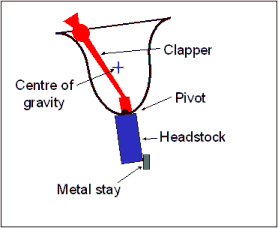How the Bells are Rung
|
In England church bells are rung by swinging them through nearly a
full circle and this gives them their unique tones as the ringing bell is moving
backwards and forwards.
With the more traditional tower bells this is achieved using a rope
attached to a large wheel (about the same size as the bell) connected to the
bell. At East Bergholt, the bells are hung in the same way but without a wheel.
They are rung by holding onto the blue headstock and pushing.
Tower ringers are able to change the ringing sequence on every
round, referred to as call changes or ringing methods. At East
Bergholt, we do not have the same degree of control as tower ringers,
but we can still change the ringing order, it just takes us a couple
of rounds to make the change and settle down to regular ringing.
Changes are signalled by hand. |
 |
With the centre of gravity of the bell lying well outside the pivot, the
bells swing like a pendulum, moving very rapidly through the lower part of
their swing. This can be best seen on the video.
On the Tenor bell the centre of gravity is about 4 ft. (1.2m) higher at the
top of the swing than at the bottom. This bell weighs 26 cwt. (1328 Kg) the same
as a motor car. The stable position is with the bell facing downwards (the
solid outline rotated through 180 degrees). Moving the bell from the stable to
the ringing position is like lifting a motor car 4ft - as you can imagine,
not very easy with only your bare hands.
To make life easier for us we leave the bells pointing upwards, resting on
a stay. Most visitors ask "why are the bells upside down", probably referring
to the pictures we see on Christmas cards. You now know the truth! It's the
pictures on the Christmas cards that are upside down.
Another commonly held misconception, when people see the bells swinging,
is that the bell hits the clapper. If you watch the video you will see that the clapper actually swings
faster than the bell and hits the bell at the top of the stroke.
The bells are mounted in a wooden frame inside the cage. The square bell frame, built from massive oak timbers
is built on a small brick plinth. Overall it is about 6ft (1.8m) high with a
narrow walkway about half way up. The ringers stand on this narrow board and
lean over the frame to ring the bells. You can just see the walkway on the
drawing of the ringers.
Swinging such massive pieces of metal and maintaining the precise timing
needed to keep the ringing sequence takes a great deal of practice. In the past
there used to be five ringers, one for each bell. New recruits would come every
Sunday to watch and listen, only to take over when the ringer of that bell
died. Nowadays, with the pressure of modern living we have a band of ten
ringers, even so, it still takes two years for somebody to learn to ring these
unique bells and become a fully fledged member of the band.
